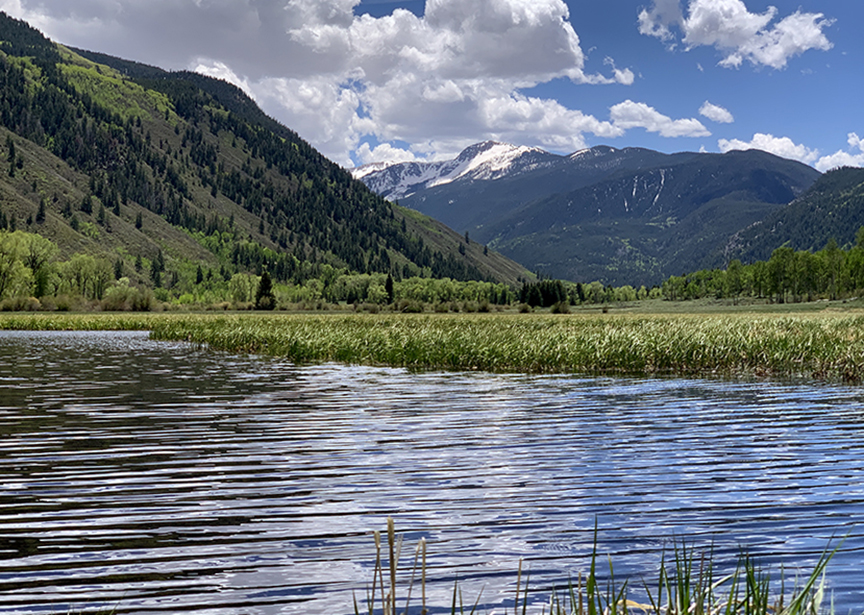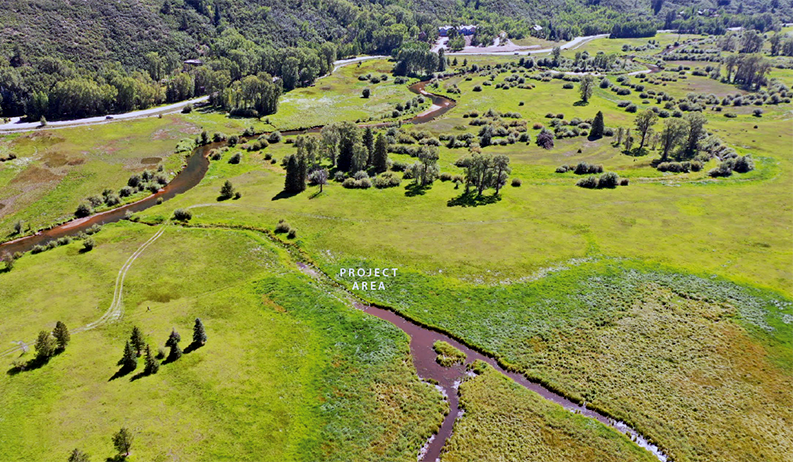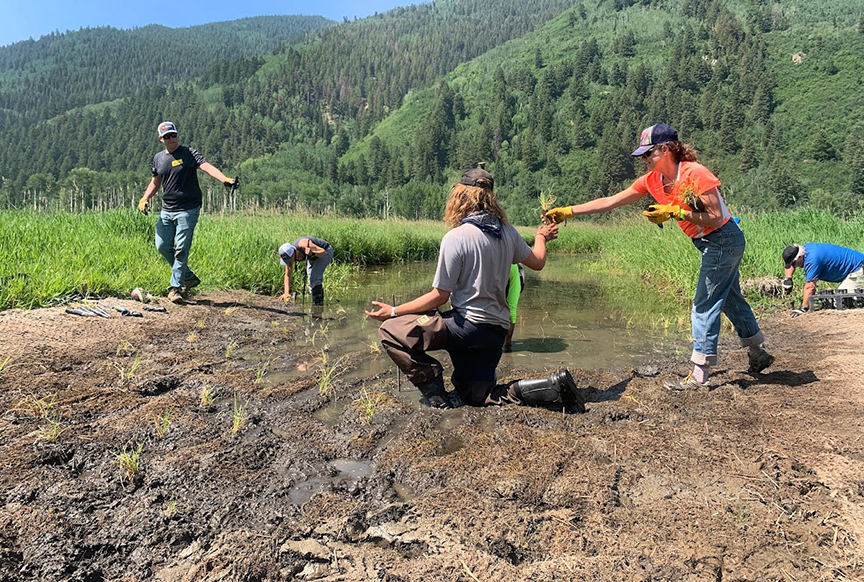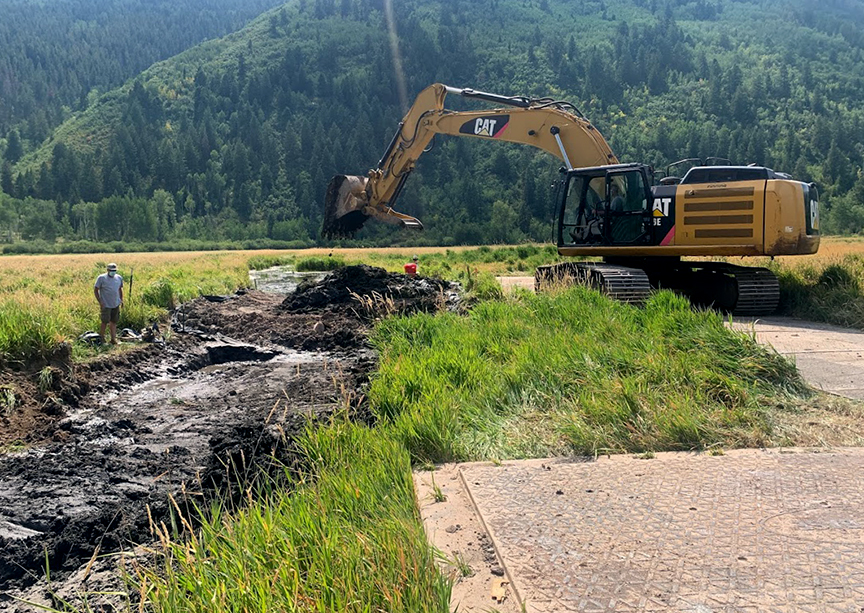Restoration of North Star’s fen shows promise

The fen at North Star Nature Preserve in 2022.
In the 1950s, a rare old-growth wetland near Aspen began slowly dying. Thousands of years in the making, the “fen,” as such wetlands are known, was succumbing to the forces of humankind – namely, an intentional effort to drain it for agricultural purposes. Two years ago, Pitkin County Open Space and Trails stepped in to alter its fate.
A carefully engineered effort to plug a drainage ditch and keep more water in the fen at North Star Nature Preserve is showing initial signs of success. Monitoring of the site in 2022 showed increased saturation, a slight uptick in native plant growth and a limited, but encouraging decline in reed canarygrass – an invasive species that was overtaking areas of the fen as it dried out. Successive years of monitoring are planned.
“Ecological restoration is rarely a quick fix, but we’re hoping to create conditions that put things back on the right trajectory so nature can recover through its own process,” said Liza Mitchell, natural resource planner and ecologist with Open Space and Trails.
Unique among wetlands
The perennially soggy spot in the northwest corner of North Star offers more than meets the eye. Surface water from adjacent Bell Mountain, spring water and mineral-laden groundwater saturate this low spot, spurring the growth of native wetland plants. In the waterlogged conditions, the plant litter doesn’t completely decompose at the end of each growing season. Instead, it accumulates and becomes compacted. The result is peat, which forms a layer many feet thick over a long period of time. Based on the depth of its peat layer, the North Star fen is estimated to be 6,700 years old.
Fens are rare and unique in the wetland world. They occupy a small percentage of the landscape, but are hotspots of biodiversity and often home to rare plants, insects and small mammals. They also provide important ecosystem services by storing water, filtering out pollutants and storing significant amounts of atmospheric carbon. The North Star fen, at roughly 14 acres, is also important to birds, including waterfowl, amphibians and large mammals.
In 2018, Open Space and Trails hired consultants to help assess the North Star fen’s hydrology. It became apparent the wetland was in trouble. Much of the area was drying out by mid-summer, with only a small portion remaining saturated throughout the growing season. When an area dries out, oxygen reaches the peat and decomposition occurs, releasing carbon to the atmosphere and shrinking the peat “sponge” for future years. Once destroyed, a fen is not easily restored due to the slow rate at which peat accumulates.
The wettest portion of the fen at North Star was dominated by native wetland plants, particularly beaked sedge. The drier portions were dominated by reed canarygrass. This aggressive invader forms dense stands that suppress native plants and reduce plant diversity, which in turn reduces the habitat value to wildlife.
Reed canarygrass cannot, however, survive sustained periods of flooding. Returning the fen to a wetter state was deemed critical to its long-term persistence.
Plugging the drain
In 2018, a plan was devised to plug a large drainage ditch that had been constructed during North Star’s prior, ranching days, when the goal had been to make the land more suitable for grazing or hay production. The ditch was really more canal than ditch – some 700 feet long, 10 to 15 feet wide and 3 feet deep, on average. Open Space and Trails installed a gated culvert at the northeastern end of the ditch in the mid-2000s, but even with the gate closed, water continued to flow out.
In 2020, the plan was put into action. Equipment operators harvested fill material onsite from spoils piles left from the original excavation of several drainage ditches and used it to help plug the big ditch. The base of the ditch, near the fen, was raised by a foot and a half. The goal was slowing the flow of water while providing a substrate that would encourage the growth of native sedges, rushes and grasses, which were seeded toward the end of the project in 2020.
In 2021, participants in a Roaring Fork Outdoor Volunteers project enhanced the revegetation effort by planting wetland plants into the restoration plug.
Measuring success
To monitor the effects of the plug, four permanent transects were established to track changes in vegetation over time. In addition, water saturation levels in the fen are measured.
The initial monitoring, in 2022, produced encouraging results. Overall, a 10.4 percent increase in native plants was documented. Most of the improvement occurred along one transect, which exhibited a 34 percent increase in native vegetation. One new native plant species was also observed. A large decrease in the amount of reed canarygrass along the transect was also recorded. Overall, a slight decrease in canarygrass throughout the fen occurred.
Additionally, water saturation levels in the fen were monitored in May, July and August of 2022 and compared to pre-restoration levels recorded in 2018. By the end of July 2022, the saturated area of the fen was about 27 percent greater than in July 2018; it was about 70 percent greater in August 2022 than in August 2018.
The outcome is promising, said OST’s Mitchell.
“We will continue to monitor and intervene when necessary, but so far it looks like conditions are shifting in the right direction,” she said.
The North Star fen restoration project involved the work of several contractors/consultants working with Pitkin County Open Space and Trails – Lotic Hydrological LLC, Buscher Soil & Environmental Inc., Peak Ecological Services LLC, DHM Design Inc and Diggin’ It Riverworks Inc. The Aspen Preserve HOA and Gary Davis allowed the use of private property for access to North Star by heavy machinery.
-By Pitkin County Open Space and Trails
KEY LINK
Fen Vegetation & Hydrology Monitoring Report Post-Restoration Year 2022

The plug was inserted into a drainage ditch leading from the North Star fen to the Roaring Fork River.

Participants with Roaring Fork Outdoor Volunteers planted native plants into the plug.

The plug was constructed with spoils collected onsite. Protective pads were placed beneath the heavy machinery.
